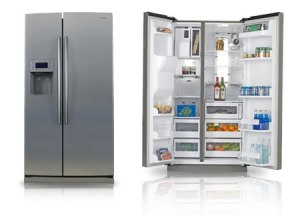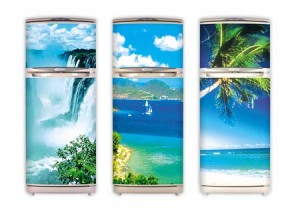Keri Algar
 Samsung Zipel e-diary
Samsung Zipel e-diary
No one can better appreciate the luxury of an ice-cold beer than an Australian. In fact we can thank one of our own, James Harrison, who in 1856 pioneered the refrigeration process. It’s first practical commercial use? A Geelong brewery, of course.
These days, cooling appliances grace 99.9% of Australian households and are mostly used to keep food fresh. A third of us use a second fridge for keeping the booze cool.
The big square box in the kitchen hasn’t really seen a revolution in the last 150 years, but there have been enough changes to raise an eyebrow or two.
Like smart-fridges. That’s right, in the tradition of smart-phones, these cool boxes come with a 10” touch screen and WiFi connectivity so you can check the weather, news or recipes while pottering around in the kitchen. It will even tell you when you are running low on milk.
The smart-fridge could be a hit in Korea where it has just been released, but do greasy hands and touch screens mix well in the Australian kitchen?
Babak Hadi, founder of Fortitude Valley’s Black Pearl Epicure, thinks smart-fridges are a waste of time and won’t catch on.
 A Samsung for Australia
A Samsung for Australia
“People do not stand up and do things on the internet…in front of the fridge. All our internet use, whether it’s ordering food or researching recipes we do sitting down. It sounds fancy and very technical but I don’t think it has long legs to stand on in terms of practicality,” says Hadi.
So if on-line fridges aren’t the flavour of the month in Australia, what is?
Hadi singles out the cool drawer concept found on some french door models, where shelves can be drawn outwards.
“It’s a concept taken from the commercial kitchen where drawers can act under all temperatures; so a drawer can be a freezer, a refrigerator or a wine fridge. The versatility in temperature application is brilliant,” says Hadi.
Frost-free systems and separate humidity control crispers have been important advancements as well in terms of reducing food spoilage.
“Compartments which allow for a degree of change in humidity are extremely important for maintaining cheeses or vegetables in good condition,” says Hadi.
What’s more, the drawer system tackles a problem we all have, finding the stuff at the back of the fridge we can’t see, and eventually don’t want to.
“Things in the back can stay there for years actually,” Hadi admits with a laugh. “But we can avoid it with a drawer where shelves can be drawn outwards so you can see what’s there. That doesn’t exist in stand-up fridges where to get to the back we have to move everything away from the front,” he continues.
Like most modern day appliances the evolution of the fridge depends on convenience. Refrigerators with ice and water dispensers are the most popular features consumers are looking for, says Traci Marsh from Clive Anthonys.
“They’ve been a hit,” says Marsh. “We’ve been selling a lot of side by sides that come with ice and water; if you’ve got a family it helps them drink more water,” says Marsh.
“They’ve really come down in price as well,” she adds.
 No wallflowers
No wallflowers
It’s no surprise that as much as intelligent design is important, a fabulous looking fridge is what really matters. It’s probably the number one criteria when buying a fridge, says Hadi. Marsh also points out that sophisticated looking fridges sell.
“The cosmetic look is very important. Bosch has brought out a black design which is really quite elegant…people like that,” says Marsh.
Samsung collaborates with Italian jewellery designers and Smeg has a 1950’s retro range.
While fashion extends to fridges, functional mod cons include anti-bacterial coating, vacation energy mode, door alarms, spill proof shelves, and LED/LCD displays to let you know what’s happening inside.
“With couples you tend to find that the wife is looking at (all) the little gadgets and the husbands are the ones looking at the energy ratings,” says Marsh, raising another significant reason why Australians pick one appliance over another. Running costs.
“Electricity has gone up and people are worried. Fridges have really come a long way now especially with energy efficiency,” says Marsh.
According to the Australian Greenhouse Office (AGO), fridges and freezers use 9% of all household appliance energy, including transport.
It pays to look at energy star ratings. The difference between running a four star or three star fridge over 10 years is roughly $300, according to AGO calculations.
Being energy wise might not be our strong point. Marsh says that even small families or couples are opting for large fridges. “People are still going for bigger fridges because they’ve come down in price so much, compared to say, four years ago,” says Marsh.
Though we spend less time in the kitchen than we did 10 years ago, cooking and entertaining has become more of a past-time than a chore. So you may as well enjoy the utility and aesthetics of your kitchen fridge.
“Food is part of our lifestyle, a hobby, it’s entertainment and a family affair. It’s like wine, it’s not just about drinking alcohol, it’s a leisure time,” says Hadi.











